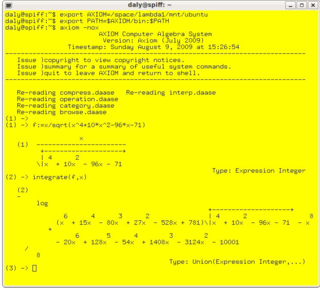
In mathematics, an equivalence relation is a binary relation that is reflexive, symmetric and transitive. The equipollence relation between line segments in geometry is a common example of an equivalence relation.

In mathematics, when the elements of some set have a notion of equivalence, then one may naturally split the set into equivalence classes. These equivalence classes are constructed so that elements and belong to the same equivalence class if, and only if, they are equivalent.

In mathematics, an isomorphism is a structure-preserving mapping between two structures of the same type that can be reversed by an inverse mapping. Two mathematical structures are isomorphic if an isomorphism exists between them. The word isomorphism is derived from the Ancient Greek: ἴσοςisos "equal", and μορφήmorphe "form" or "shape".
In geometry, a geodesic is a curve representing in some sense the shortest path (arc) between two points in a surface, or more generally in a Riemannian manifold. The term also has meaning in any differentiable manifold with a connection. It is a generalization of the notion of a "straight line".
In mathematics, a von Neumann algebra or W*-algebra is a *-algebra of bounded operators on a Hilbert space that is closed in the weak operator topology and contains the identity operator. It is a special type of C*-algebra.
Discrete mathematics is the study of mathematical structures that are fundamentally discrete rather than continuous. In contrast to real numbers that have the property of varying "smoothly", the objects studied in discrete mathematics – such as integers, graphs, and statements in logic – do not vary smoothly in this way, but have distinct, separated values. Discrete mathematics, therefore, excludes topics in "continuous mathematics" such as calculus and analysis.
In mathematics, computer science, and logic, rewriting covers a wide range of methods of replacing subterms of a formula with other terms. Such methods may be achieved by rewriting systems. In their most basic form, they consist of a set of objects, plus relations on how to transform those objects.
The Knuth–Bendix completion algorithm is a semi-decision algorithm for transforming a set of equations into a confluent term rewriting system. When the algorithm succeeds, it effectively solves the word problem for the specified algebra.

In computer science, confluence is a property of rewriting systems, describing which terms in such a system can be rewritten in more than one way, to yield the same result. This article describes the properties in the most abstract setting of an abstract rewriting system.
In computational mathematics, a word problem is the problem of deciding whether two given expressions are equivalent with respect to a set of rewriting identities. A prototypical example is the word problem for groups, but there are many other instances as well. A deep result of computational theory is that answering this question is in many important cases undecidable.
In mathematics, a classification theorem answers the classification problem "What are the objects of a given type, up to some equivalence?". It gives a non-redundant enumeration: each object is equivalent to exactly one class.
In abstract rewriting, an object is in normal form if it cannot be rewritten any further, i.e. it is irreducible. Depending on the rewriting system, an object may rewrite to several normal forms or none at all. Many properties of rewriting systems relate to normal forms.
In mathematics, in the theory of rewriting systems, Newman's lemma, also commonly called the diamond lemma, states that a terminating abstract rewriting system (ARS), that is, one in which there are no infinite reduction sequences, is confluent if it is locally confluent. In fact a terminating ARS is confluent precisely when it is locally confluent.
In mathematics, a representation is a very general relationship that expresses similarities between mathematical objects or structures. Roughly speaking, a collection Y of mathematical objects may be said to represent another collection X of objects, provided that the properties and relationships existing among the representing objects yi conform, in some consistent way, to those existing among the corresponding represented objects xi. More specifically, given a set Π of properties and relations, a Π-representation of some structure X is a structure Y that is the image of X under a homomorphism that preserves Π. The label representation is sometimes also applied to the homomorphism itself.
In differential geometry, a Kähler–Einstein metric on a complex manifold is a Riemannian metric that is both a Kähler metric and an Einstein metric. A manifold is said to be Kähler–Einstein if it admits a Kähler–Einstein metric. The most important special case of these are the Calabi–Yau manifolds, which are Kähler and Ricci-flat.

In mathematics and computer science, computer algebra, also called symbolic computation or algebraic computation, is a scientific area that refers to the study and development of algorithms and software for manipulating mathematical expressions and other mathematical objects. Although computer algebra could be considered a subfield of scientific computing, they are generally considered as distinct fields because scientific computing is usually based on numerical computation with approximate floating point numbers, while symbolic computation emphasizes exact computation with expressions containing variables that have no given value and are manipulated as symbols.
In mathematical logic and theoretical computer science, an abstract rewriting system is a formalism that captures the quintessential notion and properties of rewriting systems. In its simplest form, an ARS is simply a set together with a binary relation, traditionally denoted with ; this definition can be further refined if we index (label) subsets of the binary relation. Despite its simplicity, an ARS is sufficient to describe important properties of rewriting systems like normal forms, termination, and various notions of confluence.
In mathematical logic, a term denotes a mathematical object while a formula denotes a mathematical fact. In particular, terms appear as components of a formula. This is analogous to natural language, where a noun phrase refers to an object and a whole sentence refers to a fact.
Mathematics is a broad subject that is commonly divided in many areas that may be defined by their objects of study, by the used methods, or by both. For example, analytic number theory is a subarea of number theory devoted to the use of methods of analysis for the study of natural numbers.
In computer science, algebraic semantics is a form of axiomatic semantics based on algebraic laws for describing and reasoning about program specifications in a formal manner.















